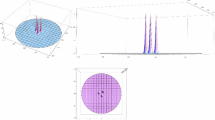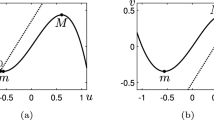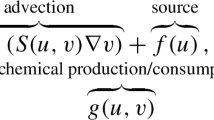Abstract
The structure, linear stability, and dynamics of localized solutions to singularly perturbed reaction–diffusion equations have been the focus of numerous rigorous, asymptotic, and numerical studies in the last few decades. However, with a few exceptions, these studies have often assumed homogeneous boundary conditions. Motivated by the recent focus on the analysis of bulk-surface coupled problems, we consider the effect of inhomogeneous Neumann boundary conditions for the activator in the singularly perturbed one-dimensional Gierer–Meinhardt reaction–diffusion system. We show that these boundary conditions necessitate the formation of spikes that concentrate in a boundary layer near the domain boundaries. Using the method of matched asymptotic expansions, we construct boundary layer spikes and derive a class of shifted nonlocal eigenvalue problems analogous to those studied in Maini et al. (Chaos 17(3):037106, 2007) for which we rigorously prove partial stability results. Moreover, by using a combination of asymptotic, rigorous, and numerical methods we investigate the structure and linear stability of selected one- and two-spike patterns. In particular, we find that inhomogeneous Neumann boundary conditions increase both the range of parameter values over which asymmetric two-spike patterns exist and are stable.










Similar content being viewed by others
References
Berestycki, H., Wei, J.: On singular perturbation problems with robin boundary condition. Annali della Scuola Normale Superiore di Pisa-Classe di Scienze 2(1), 199–230 (2003)
Dillon, R., Maini, P., Othmer, H.: Pattern formation in generalized turing systems. i: Steady-state patterns in systems with mixed boundary conditions. J. Math. Biol. 32, 04 (1994)
Doelman, A., Gardner, R.A., Kaper, T.: Large stable pulse solutions in reaction-diffusion equations. Indiana Univ. Math. J. 50(1), 443–507 (2001)
Gierer, A., Meinhardt, H.: A theory of biological pattern formation. Kybernetik 12(1), 30–39 (1972)
Gomez, D., Ward, M.J., Wei, J.: The linear stability of symmetric spike patterns for a bulk-membrane coupled Gierer–Meinhardt model. SIAM J. Appl. Dyn. Syst. 18(2), 729–768 (2019)
Iron, D., Ward, M.J., Wei, J.: The stability of spike solutions to the one-dimensional Gierer–Meinhardt model. Phys. D 150(1–2), 25–62 (2001)
Kolokolnikov, T., Paquin-Lefebvre, F., Ward, M.J.: Stable asymmetric spike equilibria for the Gierer–Meinhardt model with a precursor field. IMA J. Appl. Math. 85(1), 605–634 (2020)
Levine, H., Rappel, W.-J.: Membrane-bound Turing patterns. Phys. Rev. E (3) 72(6), 061912 (2005)
Madzvamuse, A., Chung, A.H.W., Venkataraman, C.: Stability analysis and simulations of coupled bulk-surface reaction-diffusion systems. Proc. A 471(2175), 20140546 (2015)
Maini, P., Painter, K., Chau, H.P.: Spatial pattern formation in chemical and biological systems. J. Chem. Soc. Faraday Trans. 93(20), 3601–3610 (1997)
Maini, P.K., Wei, J., Winter, M.: Stability of spikes in the shadow Gierer–Meinhardt system with robin boundary conditions. Chaos 17(3), 037106 (2007)
Meinhardt, H., Gierer, A.: Pattern formation by local self-activation and lateral inhibition. BioEssays 22(08), 753–760 (2000)
PDE Solutions Inc. FlexPDE 6. http://www.pdesolutions.com
Rätz, A., Röger, M.: Symmetry breaking in a bulk-surface reaction-diffusion model for signalling networks. Nonlinearity 27(8), 1805–1827 (2014)
Tzou, J.C., Ward, M.J.: The stability and slow dynamics of spot patterns in the 2D Brusselator model: the effect of open systems and heterogeneities. Phys. D 373, 13–37 (2018)
Ward, M.J.: Spots, traps, and patches: asymptotic analysis of localized solutions to some linear and nonlinear diffusive systems. Nonlinearity 31(8), R189–R239 (2018)
Ward, M.J., Wei, J.: Asymmetric spike patterns for the one-dimensional Gierer–Meinhardt model: equilibria and stability. Eur. J. Appl. Math. 13(3), 283–320 (2002)
Ward, M.J., Wei, J.: Hopf bifurcation of spike solutions for the shadow Gierer–Meinhardt model. Eur. J. Appl. Math. 14(6), 677–711 (2003)
Wei, J.: On single interior spike solutions of the Gierer–Meinhardt system: uniqueness and spectrum estimates. Eur. J. Appl. Math. 10(4), 353–378 (1999)
Wei, J.: Chapter 6 existence and stability of spikes for the Gierer–meinhardt system. In: Handbook of Differential Equations: Stationary Partial Differential Equations, vol. 5, p. 12 (2008)
Wei, J., Winter, M.: Existence, classification and stability analysis of multiple-peaked solutions for the Gierer–Meinhardt system in \({ R}^1\). Methods Appl. Anal. 14(2), 119–163 (2007)
Wei, J., Winter, M.: Mathematial Aspects of Pattern Formation in Biological Systems, Applied Mathematical Sciences Series, vol. 189. Springer (2014)
Author information
Authors and Affiliations
Corresponding author
Additional information
Communicated by Philip K. Maini.
Publisher's Note
Springer Nature remains neutral with regard to jurisdictional claims in published maps and institutional affiliations.
J. Wei is partially supported by NSERC of Canada. D. Gomez is supported by NSERC of Canada.
Appendices
Appendix A. Large \(\lambda _I\) Asymptotics of \({\mathscr {F}}_{y_0}(i\lambda _I)\)
In this appendix, we determine some key properties of \({\mathscr {F}}_{y_0}(\lambda )\) defined in (3.12). Recalling (3.13), in Fig. 11a we plot \({\mathscr {F}}_{y_0}(0)\) versus \(y_0\ge 0\). Next, we calculate the limiting behaviour of \({\mathscr {F}}_{y_0}(i\lambda _I)\) as \(\lambda _I\rightarrow \infty \). First, we let \(({\mathscr {L}}_{y_0} - i\lambda _I)^{-1} w_c(y+y_0)^2 = \Phi _R + i\Phi _I\) where \(\Phi _R\) and \(\Phi _I\) solve
with the boundary conditions \(\Phi _R'(0) = \Phi _I'(0)\) and \(\Phi _R,\Phi _L\rightarrow 0\) as \(y\rightarrow \infty \). Taking \(\lambda _I\gg 1\) and assuming that \(y={\mathcal {O}}(1)\), we obtain
If \(y_0>0\) then \(\Phi _R'(0)=0\) and \(\Phi _I'(0)=0\) are not satisfied and we must therefore consider the boundary layer at \(y=0\). Setting \(z = \lambda _I^{1/2} y\), we consider the inner expansion \(\Phi _R \sim {\tilde{\Phi }}_R(z)\) and \(\Phi _I \sim {\tilde{\Phi }}_I(z)\) where \({\tilde{\Phi }}_I\) satisfies
and must be matched to the outer, \(y={\mathcal {O}}(1)\), solution through the far-field behaviour
It is clear that the leading order solution is \({\tilde{\Phi }}_I(z) \sim \lambda _I^{-1} w_c(y_0)^2\). The constant behaviour of \(\Phi _I\) at the boundary layer therefore does not contribute to the leading order behaviour of the integral
Moreover, multiplying the right equation in (A.1) by \(w_c(y+y_0)\) and integrating we calculate
for \(\lambda _I\gg 1\) where we have used \({\mathscr {L}}_{y_0} w_c(y+y_0) = w_c(y+y_0)^2\). In summary, we have the large \(\lambda _I\) asymptotics
Note that the real part changes from positive to negative as \(y_0\) exceeds \(y_0\approx 1.0487\). In Fig. 11b, c we plot the real and imaginary parts of \({\mathscr {F}}_{y_0}(i\lambda _I)\), respectively, for select values of \(y_0\). In addition, we have included the large \(\lambda _I\) asymptotics which indicate close agreement for moderately large values of \(\lambda _I\).
Appendix B. Numerical Support for Stability Conjecture
In this appendix, we provide numerical support for the conjecture that the shifted NLEP (4.1) has a stable spectrum when \(\mu >\mu _c(y_0)\) by numerically calculating the dominant eigenvalue of the NLEP for \(0\le y_{0} \le 1.5\) and \(0\le \mu \le 10\). The numerical calculation of the spectrum was performed by truncating the domain \(0<y<\infty \) to \(0<y<20\) and discretizing it with 600 uniformly distributed points. Then, we used a finite difference approximation for the second derivatives and a trapezoidal rule discretization for the integral term to approximate the NLEP (4.1) with a discrete matrix eigenvalue problem. We then numerically calculated the dominant eigenvalue of matrix by using the eigenfunction in the Python scipy.linalg library for our numerical computation of the dominant eigenvalue. In Fig. 12a we plot \(\text {Re}\lambda _0\) versus \(y_0\) and \(\mu \). We observe the real part of the dominant eigenvalue is negative when \(\mu \) exceeds the threshold \(\mu _c(y_0)\). Additionally, in Fig. 12b we plot \(\Lambda _0-\text {Re}(\lambda _0)\) for the same range of \(y_0\) and \(\mu \) values. We observe that this difference is non-negative which suggest that \(\text {Re}\lambda _0\le \Lambda _0\).
a Plot of the real part of the dominant eigenvalue of the shifted NLEP (4.1) versus shift parameter \(y_0\) and multiplier \(\mu \). The dotted red line corresponds to the critical threshold \(\mu _c\) defined in (4.14) and the solid dark line is the zero contour of \(\text {Re}\lambda _0\). b Plot of the difference between dominant eigenvalues of \({\mathscr {L}}_{y_0}\) and the NLEP (4.1)
Appendix C. Stability of Asymmetric Two-Boundary-Spike Pattern when \(A=0\)
Previous results on the stability of asymmetric two spike equilibria of (1.2) when \(A=0\) have focused exclusively on interior multi-spike solutions (Ward and Wei 2002). To compare the \(A=B=0\) theory with our results obtained in Examples 2–4, we include here a summary of the stability of an asymmetric two-spike solution where one spike concentrates at \(x=0\) and the other concentrates at either \(x=1\) or in the interior \(0<x<1\). In both cases the NLEP (3.6a) with \(A=0\) can be written as
where for two boundary spikes we let
a Multiplier \(\mu \) in the NLEP for a two-spike solution when \(A=B=0\) and where the two spikes concentrate either at the boundaries or else one spike concentrates at the boundary and the other in the interior. b Relationship between l and D in the gluing method used to construct a two-spike solution when \(A=B=0\) and where either both spikes concentrate at the boundaries, or one spike concentrates at the boundary and the other in the interior
and in the case of one boundary and one interior spike we let
It is then straightforward to verify that \(\sigma =1\) is an eigenvalue of both matrices \({\mathscr {E}}_{bb}\) and \({\mathscr {E}}_{bi}\). The remaining eigenvalue in each case is then given by the determinant. By diagonalizing \({\mathscr {E}}\) the NLEP (C.1) can therefore be written as (4.1) with \(\mu =2\) as well as with \(\mu =2\det {\mathscr {E}}_{bb}\) and \(\mu = 2\det {\mathscr {E}}_{bi}\) for the boundary–boundary and boundary–interior cases, respectively. Since the \(A=B=0\) stability theory implies that the NLEP (4.1) is stable if and only if \(\mu >1\) (Wei 1999) we immediately deduce that the \(\mu =2\) modes are stable in both the boundary–boundary and boundary–interior cases. To determine the stability of the remaining modes, we explicitly calculate
Finally, for the boundary–boundary and boundary–interior cases we solve (5.7) and (5.20) for \(D=D(l)\), respectively, and the resulting values of \(2\det {\mathscr {E}}_{bb}\) and \(2\det {\mathscr {E}}_{bi}\) for \(0<l<1\) are shown in Fig. 13a. In particular, the asymmetric pattern with two boundary spikes is always linearly unstable, while the pattern with one boundary and one interior spike has a region of stability (with respect to the \({\mathcal {O}}(1)\) eigenvalues). In Fig. 13b we plot \(l=l(D)\) (cf. Figs. 7 and 10) for both two-spike configurations, indicating where the pattern is stable (solid line) and unstable (dashed line).
Rights and permissions
About this article
Cite this article
Gomez, D., Wei, J. Multi-spike Patterns in the Gierer–Meinhardt System with a Nonzero Activator Boundary Flux. J Nonlinear Sci 31, 37 (2021). https://doi.org/10.1007/s00332-021-09688-3
Received:
Accepted:
Published:
DOI: https://doi.org/10.1007/s00332-021-09688-3
Keywords
- Gierer–Meinhardt system
- Singular perturbation
- Matched asymptotic
- Nonlocal eigenvalue problem (NLEP)
- Spiky solution







